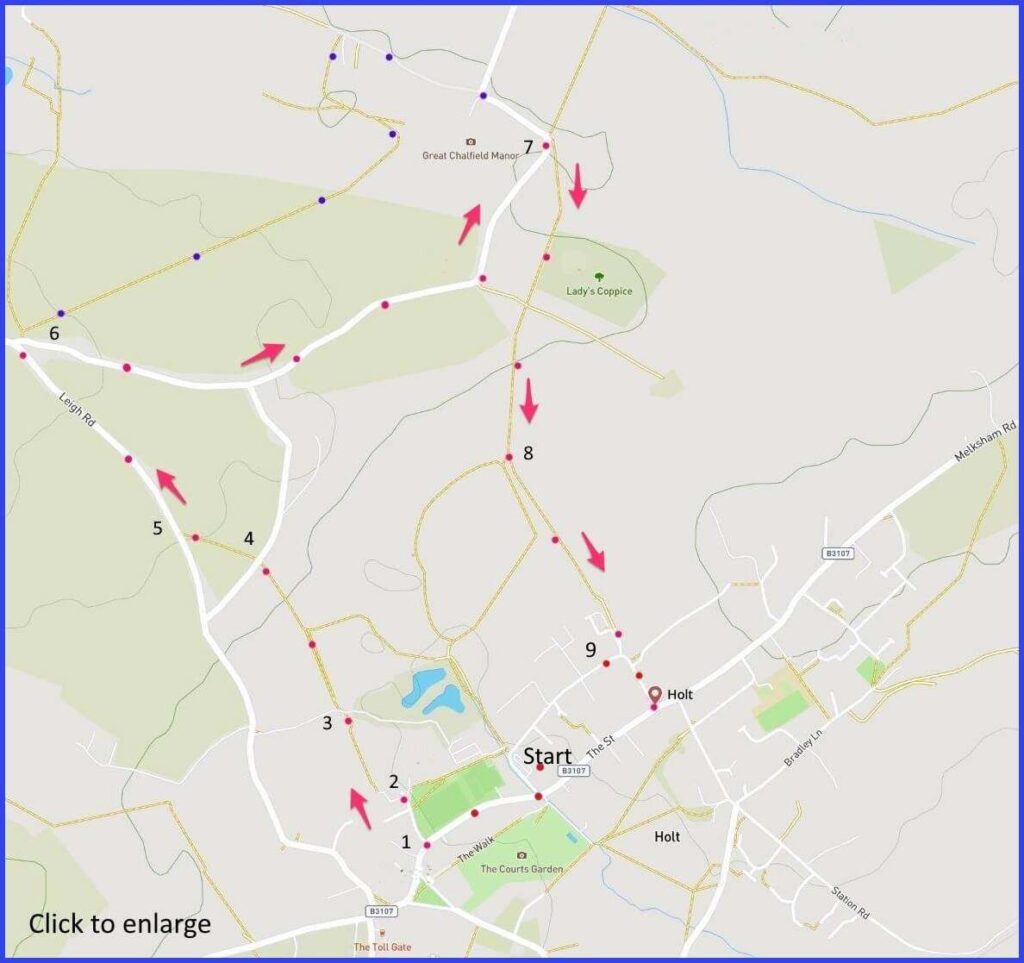(Routes from map points + metres to next point)
Start: From village car park, walk to ‘The Street’ (B3107), Turn right passing bowls clup on your right, towards Old Ham Tree pub and junction with Ground Corner. 300m
1 Turn into ‘Ground Corner’. Walk forwards to its second left turn (while facing entrance to Holt farm [A]). Left to take a short Z-path route to the start of a field footpath coming off our path to the right. Continue forward alongside trees, enter next field, head towards lane crossing. 240m
2 Follow the lane left. It turns into a fenced footpath leading to a kissing gate. Follow the path
3 Crossing a lane here and rejoining the fieldpath opposite. Walk on edge of field to a lane stile. 350m
4 Cross wider lane, enter field crossing diagonally at 45 degree angle to hidden style that joins Leigh Road. 160m
5 Turn right and walk along Leigh Road towards a lane T-junction. 500m
6 Here you have a choice. The red map markers offer a road (with good verges and little traffic) routing to the next point – which might be preferred to the field route if it is particularly muddy. The blue marker route gets you to a more useful entrance if you are visiting Chalfield Manor. 1.3km
7 At the sharp left turn in the road (pic E) follow the field path past a copse on your right to footpath junction. 650m
8 Here there are alternative paths back towards the village. The one marked on the map allows you more easily to check out the spa pump (see ‘observations’ below at point. 500m
9 The path becomes road (‘The Spa’). Walk to The Street and retrace to car park. 400m
The pictures below are in the order things were seen on this walk. Clicking on any one will enlarge it (and the slideshow)
The walk
Most of this route is across fields and lanes. While the walk is rightly termed ‘circular’, it’s really a there-and-back journey between two sites. These are the two manor houses at each end of the suggested route: The Courts in Holt, and The Manor at Great Chalfield. The notes below dwell on these sites in case you dwell a bit in either or both. Most of the walk is across fields, no great slopes. The map and guide include an alternative that keeps you a little more on paved surfaces.
Water
Why is Holt there? And why didn’t it flourish like nearby Melksham, Trowbridge, or Bradford? What a place becomes can sometimes seem to be a consequence of factors that were very ordinary, at least when considered in isolation. (And so what it does become can therefore be quite fragile.) Holt is a place whose identity (and prosperity) appears to have been shaped by a rather modest feature of its natural environment: namely, water. A tributary of the Avon made possible a cloth mill and dyehouse at The Courts: apparent today as a stream that you can now see if you stroll along the bottom of The Courts’ (very agreeable) garden. It is the source of running water that would have created some wealth for Holt and so position it as another one of the Wiltshire wool processing towns. With this in place, other related enterprises could then grow upon it. In Holt’s case that would include the production of gloves and leather goods in tannery factories established by the Beaven family during the eighteenth century.
A second way in which water defined Holt’s identity was through its standing as a spa town. When one thinks “spa” in this area, thoughts turn to Bath. Sadly, as with the case of modern social media, one monster can eclipse the competition. For a while Bath did have competition: from a group of spa towns in Wiltshire (at least 31 of them). Among which, Holt seems to have been the oldest and the most successful. The waters were drunk (bottles even sent to market in London) but also they were used for washing and bathing. All things considered; this business must have felt a resource with great potential for expansion – just as the processing of wool products similarly promised growth.
But, for many spa visitors, taking the waters probably works best when it is part of a social experience, as it was in Georgian Bath. (This is nicely covered in Sophie Vasset’s book ‘Murky Waters‘.) Did Holt simply never become fashionable enough? Perhaps it needed to cross some threshold of sociability that a sustainable spa culture depends upon: perhaps Bath had crossed this point so firmly that it dented serious competition. The signs of spa-hood seem scarce in Holt now. Although there is one piece of that history visible – at point 9 on the route map above. Here you should find a spa water pump set into the side of an old industrial building on The Midlands (a town road).
Legacy management
It’s good that trouble is taken to protect local history through these small traces. Although some communities go further. Holt has evidently considered ways in which important buildings from that history can be preserved – namely through re-purposing them (although ‘listed’ status must help). You can find at least two resourceful examples in Holt. Near map point 9 again, the old Sawtell bedding factory (‘Sleepline’) has been taken over by the Box Steam Brewery. The architecture seems agreeably matched to brewing culture (and the beer is good). The second example is the J & T Beaven tannery: a complex of buiding dating from the eighteenth century which is being converted to homes and designer workspaces. Imaginatively, artefacts from the history of work at this place are being incorporated into the setting (tanning drums, machine cogs etc). You might see all this (and try their café) if you use the Courts’ recommended parking space for your visit.
“Arts and crafts”?
Great Chalfield, at the other end of this walk, is a different scale of place. Hardly “Great” – in terms of size anyway. Just a moated manor house and a few related dwellings (although that makes it bigger than ‘Little Chalfield’ down the road). But the house (fifteenth century), the integrated church (1480), and the gardens (video) are all worth a visit. In common with The Courts, there was once a water mill on this site. But another shared feature is the ‘arts and crafts’ design of their gardens. The ‘arts and crafts’ label is often a visitor pull when it comes to buildings and furnishing, but in those cases designs seem to speak for themselves. It’s not always so clear what counts as an ‘arts and crafts’ garden. Here’s a rough suggestion: the label promises an aesthetic approach (non-formal) to planting and layout (fenced from an outside world), coupled with a skilful ‘crafting’ of planted space to promise both an intimate walking experience and a sympathetic harmony with the parent house. Anyway, both sites seem to deliver the romantic spirit rather in this manner.
Ownership
Houses like the two on this walk might suggest the question “but who owns a place like this?” Today the answer could be the National Trust although it might also be rock stars, city financiers, or other modern celebrity. Chalfield is interesting because it is currently occupied by family members from a long line of inherited ownership. In fact you may well meet them walking a dog in the garden or shepherding visitors around the house – a pleasant contrast to the more typical at-a-distance experience of country house visiting. But there is another interesting feature of ownership at Chalfield.
The house was created by Thomas Tropenell (1405-88) – although with some later Edwardian reconstruction. Tropenell illustrates a break in the traditional pattern of manorial ownership. In the middle ages, ownership might be most often associated with the church, knightly status or noble lineage. But Tropenell appears to have been of relatively humble origins. His social standing arose from his training in law and the patronage of the local baron Lord Hungerford – who Tropenell advised (over three generations) on matters of estate management. So Tropenell may represent the emergence of the ‘Tudor gentleman’ – a landowner whose manorial status owed more to confidence with the pen than with the sword. And thus a trajectory of diversity in ownership came to be.




![[A]](https://wiltshirewalks.com/wp-content/uploads/2021/12/01holt-150x150.jpg)
![[B]](https://wiltshirewalks.com/wp-content/uploads/2021/12/02holt-150x150.jpg)
![[C]](https://wiltshirewalks.com/wp-content/uploads/2021/12/03holt-150x150.jpg)
![[D]](https://wiltshirewalks.com/wp-content/uploads/2021/12/04holt-150x150.jpg)
![[E]](https://wiltshirewalks.com/wp-content/uploads/2021/12/05holt-150x150.jpg)
![[F]](https://wiltshirewalks.com/wp-content/uploads/2021/12/06holt-150x150.jpg)